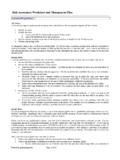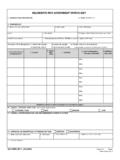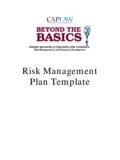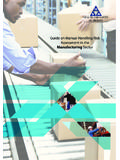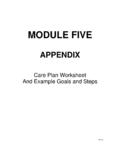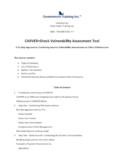Transcription of Technical Guide - Business of Security
1 Technical Guide FAIR ISO/IEC 27005 Cookbook ii Technical Guide (2010) Copyright 2010, The Open Group All rights reserved. No part of this publication may be reproduced, stored in a retrieval system, or transmitted, in any form or by any means, electronic, mechanical, photocopying, recording, or otherwise, without the prior permission of the copyright owner. It is fair use of this specification for implementers to use the names, labels, etc. contained within the specification. The intent of publication of the specification is to encourage implementations of the specification. This specification has not been verified for avoidance of possible third-party proprietary rights. In implementing this specification, usual procedures to ensure the respect of possible third-party intellectual property rights should be followed.
2 Technical Guide FAIR ISO/IEC 27005 Cookbook ISBN: 1-931624-87-9 Document Number: C103 Published by The Open Group, October 2010. Comments relating to the material contained in this document may be submitted to: The Open Group Thames Tower 37-45 Station Road Reading Berkshire, RG1 1LX United Kingdom or by electronic mail to: FAIR ISO/IEC 27005 Cookbook iii Contents 1 Introduction .. 1 Purpose .. 1 Scope .. 1 Intended Audience .. 1 Operating Assumptions .. 1 Using this Cookbook .. 2 2 How to Manage Risk .. 3 ISMS Overview .. 3 How FAIR Plugs into the ISMS .. 5 Major Differences in Approach .. 10 Recommended Approach .. 11 Points to Consider .. 11 3 What Information is Necessary for Risk Analysis? .. 13 Introduction to the Landscape of Risk.
3 13 Asset Landscape .. 13 Threat Landscape .. 15 Controls 16 Loss (Impact) Landscape .. 17 Vulnerability Landscape .. 19 4 How to use FAIR in your ISMS .. 20 Recipe for ISO/IEC 27005 Risk Management with FAIR .. 21 Define the Context for Information Risk Management .. 25 Calculate Risk .. 26 Determine the Appropriate Information Risk Treatment Plan .. 31 Develop an Information Security Risk Communication Plan .. 31 Describe the Information Security Risk Monitoring and Review Plan .. 32 A Risk Management Program Worksheet .. 33 Define the Context for Information Risk Management .. 33 Calculate Risk .. 34 Determine the Appropriate Information Risk Treatment Plan .. 36 Develop an Information Security Risk Communication Plan .. 37 Describe the Information Security Risk Monitoring and Review Plan.
4 37 iv Technical Guide (2010) Preface The Open Group The Open Group is a vendor-neutral and technology-neutral consortium, whose vision of Boundaryless Information Flow will enable access to integrated information within and between enterprises based on open standards and global interoperability. The Open Group works with customers, suppliers, consortia, and other standards bodies. Its role is to capture, understand, and address current and emerging requirements, establish policies, and share best practices; to facilitate interoperability, develop consensus, and evolve and integrate specifications and Open Source technologies; to offer a comprehensive set of services to enhance the operational efficiency of consortia; and to operate the industry's premier certification service, including UNIX certification.
5 Further information on The Open Group is available at The Open Group has over 15 years' experience in developing and operating certification programs and has extensive experience developing and facilitating industry adoption of test suites used to validate conformance to an open standard or specification. More information is available at The Open Group publishes a wide range of Technical documentation, the main part of which is focused on development of Technical and Product Standards and Guides, but which also includes white papers, Technical studies, branding and testing documentation, and Business titles. Full details and a catalog are available at As with all live documents, Technical Standards and Specifications require revision to align with new developments and associated international standards.
6 To distinguish between revised specifications which are fully backwards-compatible and those which are not: A new Version indicates there is no change to the definitive information contained in the previous publication of that title, but additions/extensions are included. As such, it replaces the previous publication. A new Issue indicates there is substantive change to the definitive information contained in the previous publication of that title, and there may also be additions/extensions. As such, both previous and new documents are maintained as current publications. Readers should note that updates in the form of Corrigenda may apply to any publication. This information is published at FAIR ISO/IEC 27005 Cookbook v This Document This document is the FAIR ISO/IEC 27005 Cookbook.
7 It has been developed and approved by The Open Group. This Guide is the third in a set of three Open Group publications addressing Risk Management: The Open Group Technical Standard: Risk Taxonomy provides a rigorous set of definitions and a taxonomy for information Security risk, as well as information regarding how to use the taxonomy. The intended audience for this document includes anyone who has the need to understand and/or analyze a risk condition. This includes, but is not limited to: Information Security and risk management professionals Auditors and regulators Technology professionals Management The Open Group Technical Guide : Requirements for Risk Assessment Methodologies identifies and describes the key characteristics that make up any effective risk assessment methodology, thus providing a common set of criteria for evaluating any given risk assessment methodology against a clearly defined common set of essential requirements.
8 In this way, it explains what features to look for when evaluating the capabilities of any given methodology, and the value those features represent. The Open Group Technical Standard: FAIR ISO/IEC 27005 Cookbook (this document) describes in detail how to apply the FAIR (Factor Analysis for Information Risk) methodology to any selected risk management framework. It uses ISO/IEC 27005 as the example risk assessment framework. FAIR is complementary to all other risk assessment models/frameworks, including COSO, ITIL, ISO/IEC 27002, COBIT, OCTAVE, etc. It provides an engine that can be used in other risk models to improve the quality of the risk assessment results. The Cookbook enables risk technology practitioners to follow by example how to apply FAIR to other risk assessment models/frameworks of their choice.
9 Intended Audience The primary target audience for this Cookbook is risk management analysts and practitioners, to help them to use ISO/IEC 27005 to achieve higher quality risk assessment results, especially given the lack of formal specificity in probabilism provided by ISO/IEC 27005, including in its difficult appendices on creation of a probabilistic model. vi Technical Guide (2010) Trademarks Boundaryless Information Flow and TOGAF are trademarks and Making Standards Work , The Open Group , UNIX , and the X device are registered trademarks of The Open Group in the United States and other countries. COBIT is a registered trademark of the Information Systems Audit and Control Association and the IT Governance Institute. ITIL is a registered trademark of the Office of Government Commerce in the United Kingdom and other countries.
10 OCTAVE is a registered trademark of Carnegie Mellon University. The Open Group acknowledges that there may be other brand, company, and product names used in this document that may be covered by trademark protection and advises the reader to verify them independently. FAIR ISO/IEC 27005 Cookbook vii Acknowledgements The Open Group gratefully acknowledges the contribution of the following people in the development of this document: Lead Authors: Christopher Carlson, The Boeing Company Alex Hutton, Verizon Contributing Author: Anastasia Gilliam, Independent Consultant Reviewers: Members of the Security Forum, The Open Group viii Technical Guide (2010) Referenced Documents The following documents are referenced in this Guide : ISO/IEC 27005:2008: Information Technology Security Techniques Information Security Risk Management.
